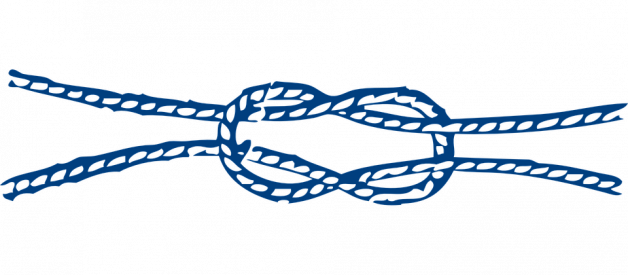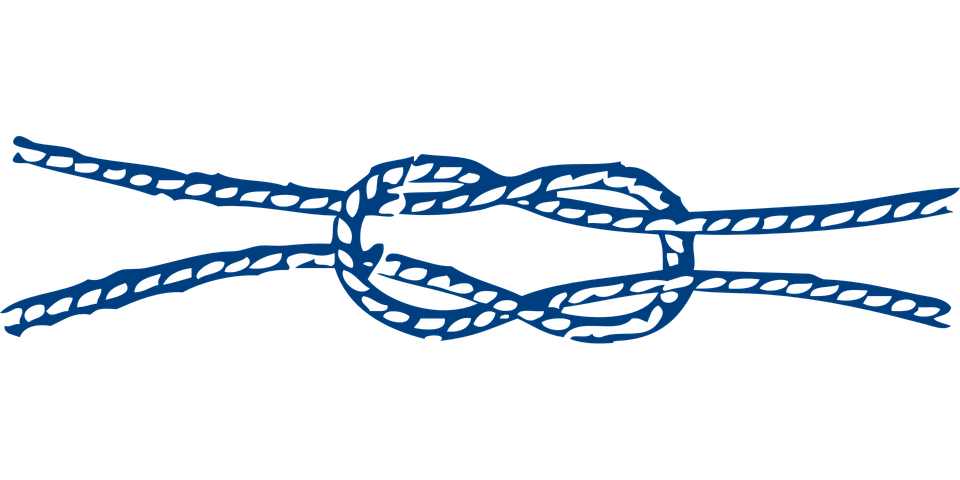 Credit: Pixabay
Credit: Pixabay
First, let?s address the elephant in the room.
This is how the word ?best? is defined by the Cambridge English Dictionary.
?of the highest quality, or being the most suitable, pleasing, or effective type of thing or person?
For me, and for the purpose of clarity in this article, we will take ?best? to mean a combination of factors based on the definition of the term. Specifically, this will refer to a given knot?s quality as being:
- suitable to a given fishing application
- pleasing insomuch that it is clear or easy to tie
- effective, in terms of tensile strength and durability.
TL;DR
Terminal Connections
1 Palomar Knot2 Jansik Knot3 San Diego Jam Knot4 Snell Knot5 Double-Palomar (Trilene Knot)6 Rapala Loop Knot
Leader Connections
7 Page Rankin Bobbin8 GT Knot9 FG Knot10 Improved Double-Uni Knot
For visual aids in learning how to tie many knots, check out the link below. It is one of my favourites. You should wet all of your lines with fresh water when tying your knots, so that the knot does not fail and is formed and secured properly.
Home
Animated Knots is the world’s leading site for learning how to tie knots of any kind. From Boating Knots, Fishing Knots?
www.animatedknots.com
Terminal Connections
- Palomar Knot
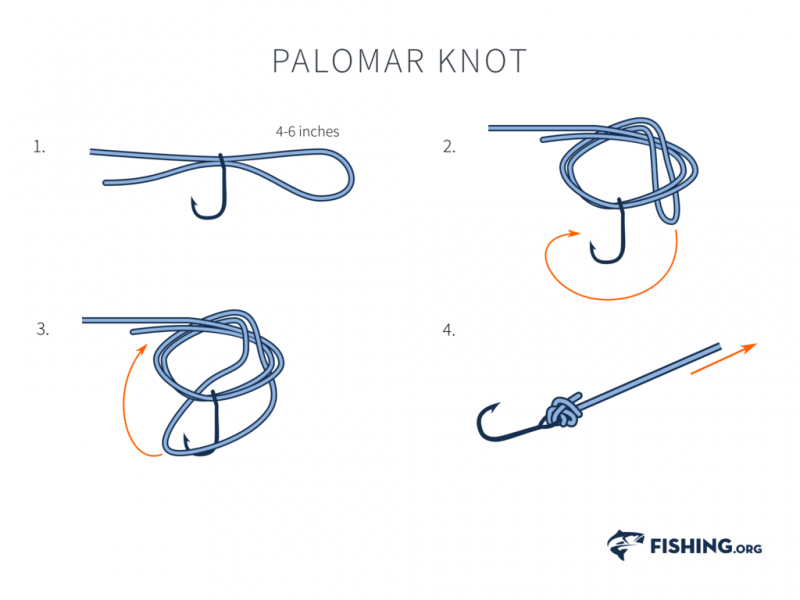 Credit: Fishing.org
Credit: Fishing.org
Suitable for just about all types of fishing applications and fishing lines; I tie a palomar knot more often than any other knot for terminal connections; You can cut the tag short, it does not slip. Most of my personal best catches have been caught with a palomar knot. It is one of the most durable, rugged, and effective knots in existence and has never failed me. Many consider the palomar knot, in terms of effectiveness, to be the holy grail of knots for terminal connections.
In my opinion, the palomar knot has three critical disadvantages. The first is that it requires you to stretch the loop over the terminal end, which is cumbersome, especially if your terminal end is connected to a long leader or big lure. The second is that it requires a doubling of the fishing line to pass through the eye of the hook, which can be impossible in some situations depending on your tackle, causing you to attach additional tackle in order to use it, such as a split ring. The third is that it can be cumbersome tying with very thick or heavy monofilament or fluorocarbon line.
The key to tying the palomar knot correctly is making sure that A) you wet the line, B) the double lines don?t overlap each other and C) that the trailing loop end is set above the initial knot (pictured in #2) as opposed to below it, over the eye of the hook.
Ross Myers introduced me to this knot.
2. Jansik Special Knot
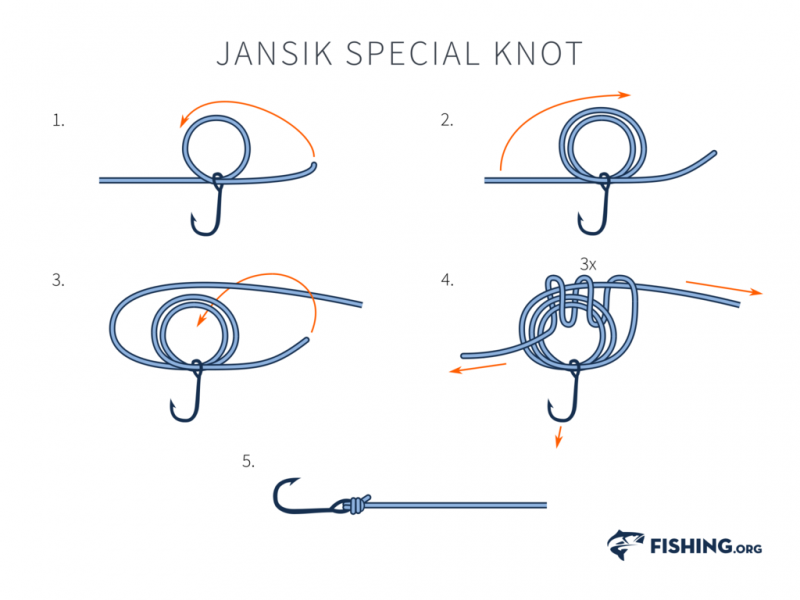 Credit: Fishing.org
Credit: Fishing.org
The Jansik Special Knot is suitable for just about all types of fishing applications and fishing lines; I most often tie it when I am using light leader, and want to tie the beginning of my terminal end to a barrel swivel. Like the palomar knot, it is rumoured to be extremely strong, effective, and revered by certain anglers as being the best knot for terminal connections that there is. It is extremely simple to tie, very effective, and holds up well with just about all types of fishing line.
The major advantage to this knot, other than being a high quality knot is that, unlike palomar, I can tie it in place ? I don?t have to wrap a loop over the terminal end. There are a few disadvantages to this knot. The first is that in order to seal this knot you have to pull in three different directions somewhat simultaneously. The second is that you need a comparatively large eye to pass three loops of the terminal line tackle through. The third follows the second in that it is impossible in many cases to tie direct line to terminal end with even moderately heavy leader material (over 20lbs in most cases). This introduces the need for a split ring or other tackle with a big enough space to tie the knot through which A) may or may not adversely impact the action of your terminal tackle and/or B) reduce the stealth quality of your terminal tackle. The fourth and perhaps the most challenging disadvantage is that is very hard to tie direct to line without a leader, as you will need to pass the main line through the loop three times to seal. This is a critical disadvantage, which is why I almost always tie this knot with a fluorocarbon leader.
I find that when I tie this knot to an angler?s clip, which I use for almost all freshwater applications as well as when I fish the surf, I have no problems with the thickness of the loops of this knot.
Bryan Dietz introduced me to this knot.
3. San Diego Jam Knot
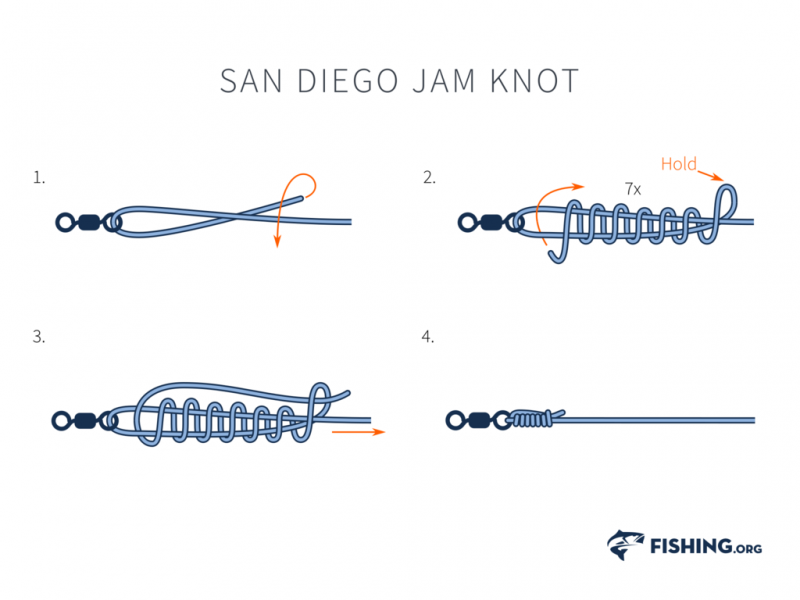 Credit: Fishing.org
Credit: Fishing.org
Suitable for most fishing applications and lines; I tie a san diego jam knot most often when I am jigging. Like the palomar knot and the jansik knot, many consider the san diego jam knot, in terms of effectiveness, to be the holy grail of knots for terminal connections. It is simply and easy to understand as well as quick and easy to tie. It is, however, bulky.
It is very durable, holds up very well, and when tied correctly, will not slip. In my personal opinion, I think this knot is best used with fluorocarbon or monofilament lines as opposed to very light braided or nanofil unifilament lines.
Having used this knot in a variety of applications, I think it is best suited for vertical jigging, bumping heavy bucktail jigs off of the bottom, or slinging topwater poppers for tuna fish or king mackerel. While it is a good knot, it is very stiff and for that reason I do not prefer it when fishing topwater plugs in a walk-the-dog style or when fishing swim bait lures. As it does not lend to free swimming action on the terminal end, I typically fish this lure in conditions where I am going in a straight direction with little or no need for any side to side or free movement. Having said that, I do not view this knot as suitable for bottom fishing live bait.
A guy I met who came to down to Miami to visit his son at UM was fishing Key Biscayne National Park and introduced me to this knot, as well as elk jerky, bison jerky, and using bare chartreuse pompano jigs to catch mutton snapper.
4. Snell Knot
 Credit: Fishing.org
Credit: Fishing.org
Most suitable for fishing with fluorocarbon or mono filament while bottom fishing with octopus or circle hooks; I tie a snell knot almost every time I fish with a circle hook. Joining the palomar knot, jansik knot and san diego jam knot, many people consider the snell knot to be of the highest level of effectiveness. While not as simple or easy to tie as the aforementioned knot, it is a go to bottom fishing knot that will hold tight.
The primary advantages of the snell knot is that the point of tension is below the eye of the hook which (in my opinion and that of others) leads to a quicker and better chance of a hookup when fishing with circle and octopus hooks as a bite from the fish leans the hook towards the side. A longtime legendary fishing staple, many fisherman will tell you that snell knots are a must when fishing with circle hooks.
The primary disadvantages to this knot are: A) offers very little protection against toothy critters, B) not as simple to tie as others, C) care need be taken to avoid scraping the line against the barb of the hook when forming the snell turns. It also, can only be tied to a hook or similar tackle with an eye or something to hold the knot.
A decade ago I saw a guy using a snell knot at a pier to bottom fish for snappers and groupers. I researched the knot on the internet, and the rest is history.
5. Rapala Loop Knot
 Credit: Fishing.org
Credit: Fishing.org
The Rapala Loop Knot is suitable for several fishing applications and just about all fishing lines; I tie a rapala loop knot every time I walk the dog with a topwater lure or throw a swimbait.
While not revered to be quite as effective in terms of tensile strength as the previous four knots, it is the strongest loop knot known to man, in my opinion. When tied properly, it will give you excellent reliability ? more than that of a regular loop not ? while not sacrificing on what makes the loop knot great ? incredible freedom for lure action. I believe all anglers should learn at least one loop knot and if you only ever learn one, this ought to be the one you learn.
The primary advantage of the loop knot is that it allows for incredible terminal end action while offering superior knot strength. In addition, it makes for a fine knot for fishing live bait, as the bait fish has more freedom to move freely. The disadvantages of this knot follow that of standard loop knot disadvantages, mainly, that it is not suitable for targeting toothy critters, and that it is not quite as strong as other knots that are woven directly down to the terminal end. In my opinion, this knot is a middle of the pack knot in terms of how easy it is to tie and understand.
I discovered this knot while browsing the internet for various types of loops knots.
6. Double-Palomar Knot(Nanofil Knot)
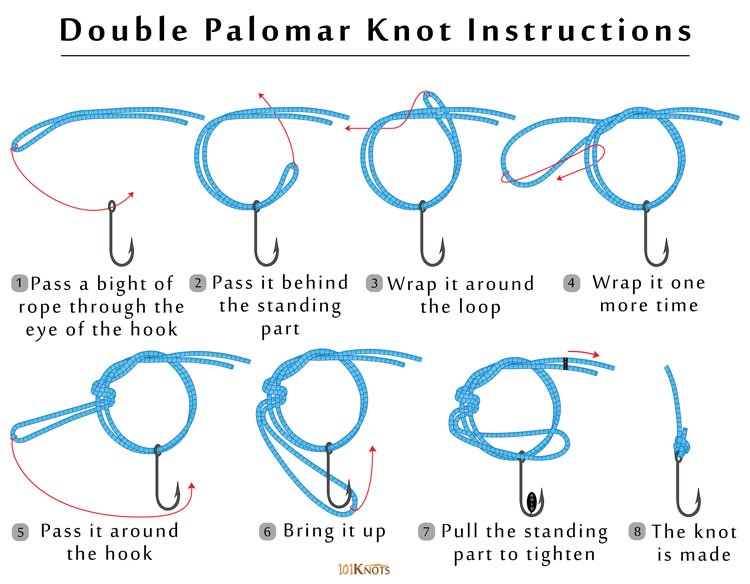 Credit: 101Knots
Credit: 101Knots
The double palomar knot is a general purpose fishing knot, that can be used in any of the applications where a palomar knot is suitable; I tie this knot every time I use nanofilament fishing line or a slick braided line of a very small diameter. It is a simple, easy to tie, reliable knot that will hold tight.
The main advantage to tying this knot, and the only reason I use it, is that it is suitable for slippery, small diameter lines, such as Berkley?s Nanofil or Power Pro?s Super Slick 8 10lbs braid. Outside of this limited context, I would not use this knot for heavier braided, wire, nylon or nylon-like lines.
I discovered this knot by natural experimentation, and rediscovered it when I noticed on the back of the packaging of Berkley?s unafilament NanoFil fishing line.
Leader Connections
7. Page Rankin? Bobbin Knot
 , mCredit: SportFishing Magazine
, mCredit: SportFishing Magazine
Let me start off by saying that for braid to mono/fluoro, this is the most effective connection there is, point blank, period. It works, it just does, and it holds up, over and over again, testing out at retaining 100% tensile strength of the main line. While it is the only knot in this article that I have not personally tied myself, I?ve seen it used and I?ve seen it tied. It does not get better, in terms of effectiveness, than the PR Bobbin knot. It is suitable for just about all fishing applications.
What?s most impressive about this knot, second to it?s tensile strength, is the fact that it glides through your rod guides easily. A disadvantage to this knot is that it is comparatively complicated to tie, considering this knot against it?s peers. What?s more, this knot requires the use of a lighter and a special tool called a bobbin, making it far less practical (dangerous even) to tie when in a pinch, on a boat. Care is needed to make sure that the bobbin is wound and unraveled properly and that the lighter does not damage the main line or the leader when applied to the tag ends. Lastly, this knot consumes far more of the main line than other knots. It is suitable for braid or braid-like to nlyon or nylon-like connections only.
I discovered this knot after reading the very popular and groundbreaking article on strongest braid to mono knots posted in Sport Fisherman magazine. A link to that article is provided at the end of this article.
8. GT Knot
 Credit: SportFishing Magazine
Credit: SportFishing Magazine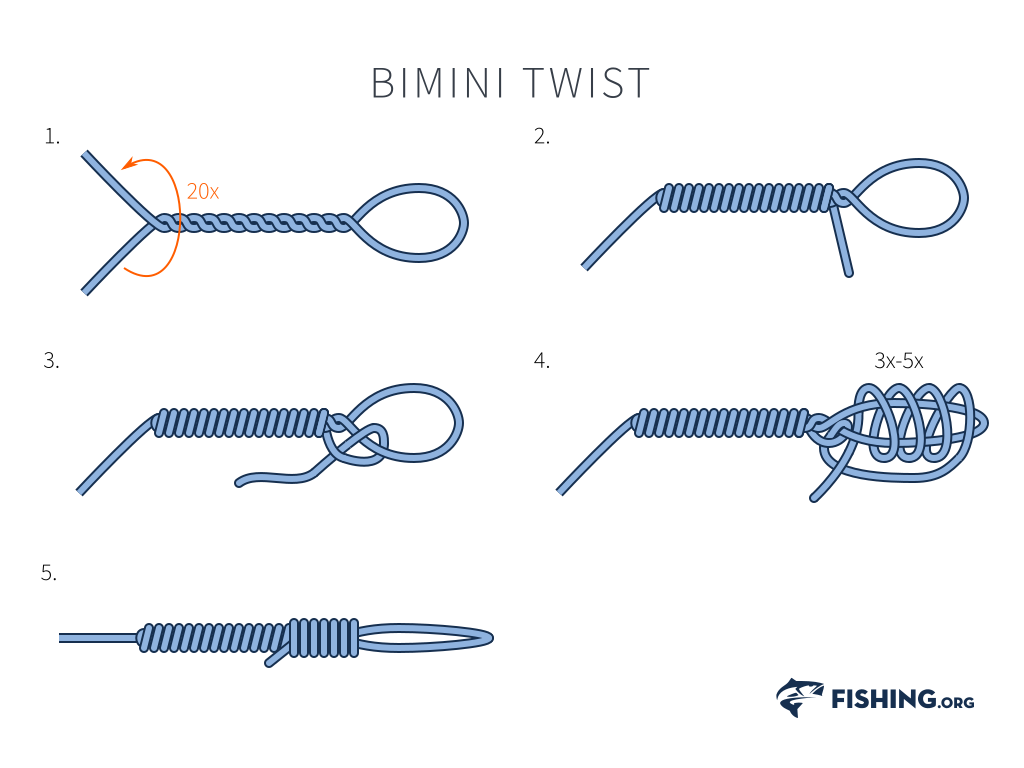 Credit: Fishing.org
Credit: Fishing.org
Following the PR Bobbin Knot, the GT Knot is a highly effective knot in terms of retaining the tensile strength of the main line in heavy line applications; It has been tested to retain 100% of the main line strength. It is most suitable for trolling, jigging, deep dropping, and bottom fishing applications; I tie this knot anytime I am using heavy line or heavy leader in non-casting applications. It is one of the most durable, rugged, and effective knots in existence and has never failed me. The clan of bimini twist faithfuls, will readily tell you that this is the only leader knot you should tie.
Overall, it is a moderate to mildly challenging knot to tie. However, the use of tools is not needed, and with practice, this knot can be tied relatively quickly on a rocking boat. It?s value as a leader in trolling applications comes from the fact that the bimini twist acts a shock leader. It has two main disadvantages. The first is that due to the size of the knots, it is not suitable for casting applications. It will not cast very smoothly, and furthermore, it is not smooth on the rod guides. The second is that it?s strength is not as superb for lighter line connections. This knot is suitable for braid or braid-like loop connections only.
Personally, I tie 25x loops on my bimini, and leave a noticeable tag on the Figure 8 hitch end.
I discovered this knot after reading the very popular and groundbreaking article on strongest braid to mono knots posted in Sport Fisherman magazine. A link to that article is provided at the end of this article.
9. FG (Freakin? Good) Knot
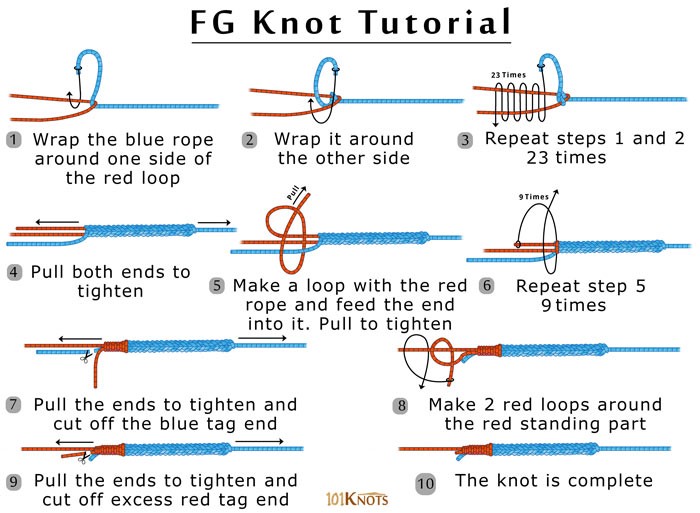 Credit: 101 Knots
Credit: 101 Knots Credit: 101 Knots
Credit: 101 Knots
One of the most inquired about connections for braid to nylon or nylon-like leaders, the FG knot has some of the most ardent supporters there is. In the same family of knots as the PR Bobbin knot, this knot is formed by making wraps around the leader and sealing those wraps using hitch knots. This knot is a general purpose knot that can be used in just about any fishing application and is particularly useful for casting applications owing to it?s small profile; I tie this leader knot more often than any other connection.
The confusing thing about tying an FG knot is that there are so many ways to form the knot or variations of the knot. I tie my FG knot in two main variations.
How I tie my FG knots:
- I make 20?26 turns of a chinese finger grip.
- Sealed by 6-8 alternating half hitches on both main line and leader with the main-line tag end
- Sealed by a double half hitch on the main line only with the main line terminal end.
For lighter line connections, I make 20?22 turns of the chinese finger grip and 6 alternating half hitches. For heavier line connections, I make 25?26 turns of the chinese finger grip and 8 alternating half hitches. I have also experimented with tying a half hitch using the leader tag end. To date, I am not sure if it holds up better than my ordinary FG knot. With a properly tied FG knot you should reasonably expect to get anywhere from 70?85% of the mainline?s actual breaking strength, which is comparatively impressive among it?s peers.
It is a comparatively moderately difficult line to tie, but with practice, it can be done in a jiffy on a rocking boat. I can probably tie mine in 5 minutes, if concentrating. I tied mine in about 9 minutes, after making a mistake, on a rocking boat.
The key, in my opinion, to a solid FG knot is to tie the finger grips and the hitch knots tightly, closely woven.
This disadvantages of this knot are that there is a steep-ish learning curve in learning how to tie it correctly and while it is one of the strongest knots there is, it is not as strong as the PR Bobbin at GT knots, which are in a class of their own. Due to it?s weaker holding strength in comparison to these knots, it is somewhat risky to apply as much drag and pressure when fishing with this knot as you might with the previous too. It is, however, by no means, weak; It is one of the strongest connections there is. The solution to this is simply to fight the fish slightly less aggressively, especially on the initial run, or tie a heavier leader.
To my mind, this is one of the best tutorials on the internet for tying an FG knot.
FG Knot
FG Knot.
www.animatedknots.com
I discovered this knot after reading the very popular and groundbreaking article on strongest braid to mono knots posted in Sport Fisherman magazine. A link to that article is provided at the end of this article.
10. Improved Double-Uni Knot
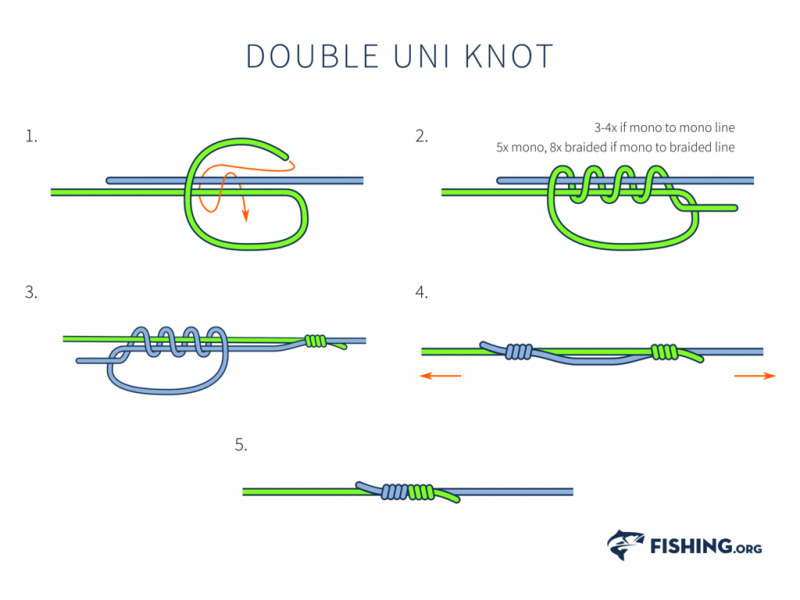 Credit: Fishing.org
Credit: Fishing.org
Suitable for almost all types of fishing applications and all fishing lines; I tie an improved double uni-know when shallow water bottom fishing and when tying mono to fluoro. This is a knot modification that I invented. The basic knot itself, however, I did not invent.
This knot is suitable for casting short leaders and for bottom fishing. This is one of the only knots on the list, that I would use for nylon to nylon-like or nylon to nylon connections. The disadvantages to this knot are that it is not as strong as other knots on this list, and after it is significantly pulled, it will need to be re-tied.It is also not suitable for casting long leaders as it is not smooth on the guides. Nevertheless, it is a relatively simple knot to to tie.
The key to tying the improved double uni is to evenly tie the uni wraps. It is absolutely critical to wet the line, in order to tie the wraps on the double uni evenly. In general, I tie a heavier braid to a lighter leader, when tying this knot. In general, I tie more wraps on the braided side than the leader side. The pound-test of the braided line, is also a factor.
Modifications to Double Uni:
- Double the braided line
- 4 to 5 wraps on the leader side + 6?8 wraps on the braided side
- or (in nylon to nlyon connections) 5 wraps on lighter side, 4 wraps on heavier side
- Single half hitch both tag ends in nylon to nylon connections
- or double half hitch using the braided tag end to the braided main line + single half hitch on the nylon line.
Steve Brown introduced me to the original Double-Uni Knot. Thereafter, I experimented with improvements.
This article was originally published on the blog section of my homepage, here.
My Closing Thoughts
The best knots to tie are the ones that you can tie effectively, consistently, and that hold up the best. While there is no ?best? knot for everyone, knots are a critical part of your rig and can make the difference between a landed fish or a would-be-personal best swimming away. Surely, there are other excellent knots that did not make my list such as the Improved FG or the Surgeon?s Knot.
If you?re curious how some of these knots hold up, or want to discover more knots, check out the following:
Strongest Fishing Knots Connecting Braid to Leader
Sport Fishing tested 53 knots connecting braided line to fluorocarbon leader to find out which produce the strongest?
www.sportfishingmag.com
 Source: Looney Tunes Ending
Source: Looney Tunes Ending
